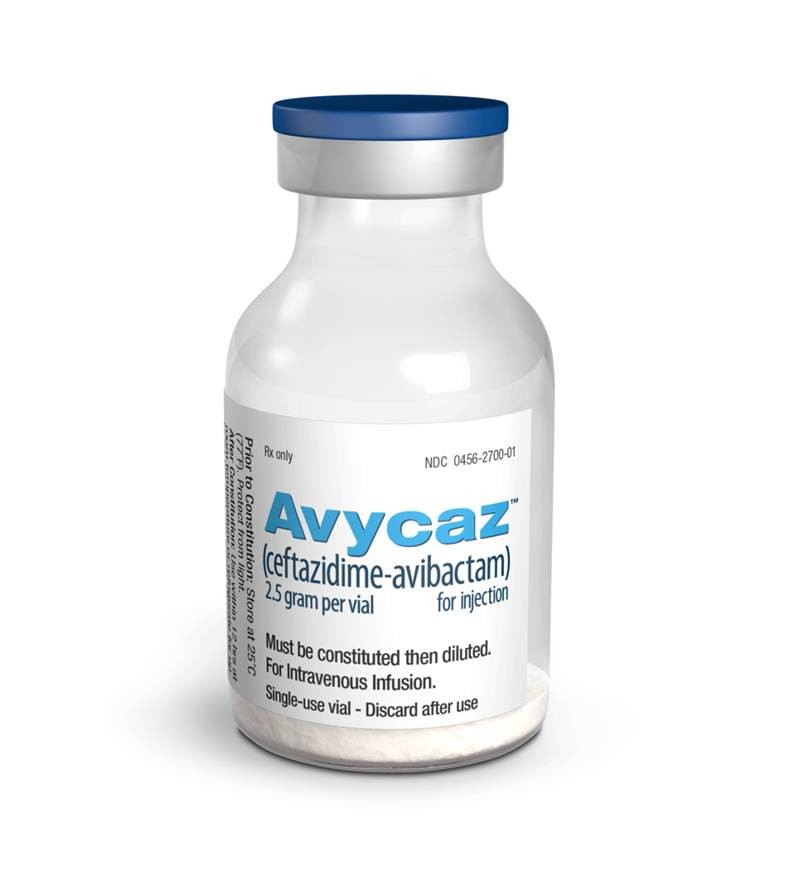
Contents
Avycaz
Avycaz is an antibacterial combination drug used to treat complicated intra-abdominal infections (cIAI) in combination with metronidazole, and complicated urinary tract infections (cUTI), including pyelonephritis.
Side effects of Avycaz
Common side effects include:
Dosage for Avycaz
Recommended Dosage for Adult Patients
The recommended dosage of Avycaz is 2.5 grams (ceftazidime 2 grams and avibactam 0.5 grams) administered every 8 hours by intravenous (IV) infusion over 2 hours in patients 18 years and older with CrCl greater than 50 mL/min.
For treatment of cIAI, metronidazole should be given concurrently. The guidelines for dosage of Avycaz in patients with creatinine clearance (CrCl) greater than 50 mL/min are listed in Table 1.
Table 1. Dosage of Avycaz 2.5 grams (ceftazidime 2 grams and avibactam 0.5 grams) by Indication
| Infection | Dose | Frequency | Infusion Time (hours) | Duration of Treatment |
| Complicated Intra-abdominal Infections [used in combination with metronidazole] (cIAI) | 2.5 grams | Every 8 hours | 2 | cIAI: 5 to 14 days |
| cUTI: 7 to 14 days | ||||
| HABP/VABP: 7 to 14 days | ||||
| Complicated Urinary Tract Infections including Pyelonephritis (cUTI) | ||||
| Hospital-acquired Bacterial Pneumonia and Ventilator-associated Bacterial Pneumonia (HABP/VABP) |
Recommended Dosage in Pediatric Patients with cIAI or cUTI
- The recommended dosage of Avycaz in pediatric patients aged 2 to < 18 years with cIAI or cUTI and an estimated glomerular filtration rate (eGFR) greater than 50 mL/min/1.73 m 2 and in pediatric patients aged 3 months to < 2 years without renal impairment is described in Table 2.
- Avycaz is administered every 8 hours by intravenous infusion over 2 hours.
- For treatment of cIAI, metronidazole should be given concurrently.
- There is insufficient information to recommend a dosing regimen for pediatric patients with HABP/VABP.
Table 2. Dosage of Avycaz (ceftazidime and avibactam) in Patients 3 months to < 18 years
| Infection | Age Range | Dose | Frequency | Infusion Time (hours) | Duration of treatment |
| cIAI* and cUTI including Pyelonephritis | 2 years to less than18 years a | Avycaz 62.5 mg/kg to a maximum of 2.5 grams (Ceftazidime 50 mg/kg and avibactam 12.5 mg/kg to a maximum dose of ceftazidime 2 grams and avibactam 0.5 grams) | Every 8 hours | 2 | cIAI: 5 to 14 days |
| cUTI: 7 to14 days | |||||
| 6 months to less than 2 years | Avycaz 62.5 mg/kg (Ceftazidime 50 mg/kg and avibactam 12.5 mg/kg) | ||||
| 3 months to less than 6 months | Avycaz 50 mg/kg (Ceftazidime 40 mg/kg and avibactam 10 mg/kg) | ||||
| a For pediatric patients (2 years or older) with eGFR less than or equal to 50 mL/min/1.73m 2 , dosage adjustments are recommended [see Dosage Adjustments In Adult And Pediatric Patients (2 Years And Older) With Renal Impairment]. * Avycaz was used in combination with metronidazole in cIAI pediatric patients |
|||||
Dosage Adjustments in Adult and Pediatric Patients (2 Years and Older) with Renal Impairment
- The recommended Avycaz dosage in adult and pediatric patients 2 years and older with varying degrees of renal function is presented in Table 3 and Table 4, respectively.
- For patients with changing renal function, monitor CrCl in adults or eGFR in pediatric patients at least daily and adjust the dosage of Avycaz accordingly.
- There is insufficient information to recommend a dosing regimen for pediatric patients less than 2 years of age with renal impairment.
Adult Patients
Table 3. Dosage of Avycaz in Adult Patients with Renal Impairment
| Estimated Creatinine Clearance (mL/minute) a | Dose for Avycaz (ceftazidime and avibactam) b | Frequency |
| 31 to 50 | Avycaz 1.25 grams (ceftazidime 1 gram and avibactam 0.25 grams) intravenously | Every 8 hours |
| 16 to 30 | Avycaz 0.94 grams (ceftazidime 0.75 grams and avibactam 0.19 grams) intravenously | Every 12 hours |
| 6 to 15c | Avycaz 0.94 grams (ceftazidime 0.75 grams and avibactam 0.19 grams) intravenously | Every 24 hours |
| Less than or equal to 5 c | Avycaz 0.94 grams (ceftazidime 0.75 grams and avibactam 0.19 grams) intravenously | Every 48 hours |
| a As calculated using the Cockcroft-Gault formula b All doses of Avycaz are administered over 2 hours c Both ceftazidime and avibactam are hemodialyzable; thus, administer Avycaz after hemodialysis on hemodialysis days |
||
Pediatric Patients
Table 4. Dosage of Avycaz for cUTI and cIAI in Pediatric Patients 2 years and older with Renal Impairment a
| Estimated eGFR b (mL/min/1.73m 2 ) |
Dose for Avycaz (ceftazidime and avibactam) c | Frequency |
| 31 to 50 | Avycaz 31.25 mg/kg to a maximum of 1.25 grams (Ceftazidime 25 mg/kg and avibactam 6.25 mg/kg to a maximum dose of ceftazidime 1 gram and avibactam 0.25 grams) | Every 8 hours |
| 16 to 30 | Avycaz 23.75 mg/kg to a maximum of 0.94 grams (Ceftazidime 19 mg/kg and avibactam 4.75 mg/kg to a maximum dose of ceftazidime 0.75 grams and avibactam 0.19 grams) | Every 12 hours |
| 6 to 15 | Avycaz 23.75 mg/kg to a maximum of 0.94 grams (Ceftazidime 19 mg/kg and avibactam 4.75 mg/kg to a maximum dose of ceftazidime 0.75 grams and avibactam 0.19 grams) | Every 24 hours |
| Less than or equal to 5 d | Avycaz 23.75 mg/kg to a maximum of 0.94 grams (Ceftazidime 19 mg/kg and avibactam 4.75 mg/kg to a maximum dose of ceftazidime 0.75 grams and avibactam 0.19 grams) | Every 48 hours |
| a Dosing was derived based on the population PK modeling, which assumed similar proportional effects of renal impairment in adults and pediatric patients 2 years and older b As calculated using the Schwartz bedside formula c All doses of Avycaz are administered over 2 hours d Both ceftazidime and avibactam are hemodialyzable; thus, administer Avycaz after hemodialysis on hemodialysis days |
||
Drug interactions with Avycaz
Probenecid
- In vitro, avibactam is a substrate of OAT1 and OAT3 transporters which might contribute to the active uptake from the blood compartment, and thereby its excretion.
- As a potent OAT inhibitor, probenecid inhibits OAT uptake of avibactam by 56% to 70% in vitro and, therefore, has the potential to decrease the elimination of avibactam when co-administered.
- Because a clinical interaction study of Avycaz or avibactam alone with probenecid has not been conducted, co-administration of Avycaz with probenecid is not recommended.
Drug/Laboratory Test Interactions
- The administration of ceftazidime may result in a false-positive reaction for glucose in the urine with certain methods. It is recommended that glucose tests based on enzymatic glucose oxidase reactions be used.
Pregnancy and breastfeeding
- There are no adequate and well-controlled studies of Avycaz, ceftazidime, or avibactam in pregnant women.
- Ceftazidime is excreted in human milk in low concentrations. It is not known whether avibactam is excreted into human milk, although avibactam was shown to be excreted in the milk of rats.
- No information is available on the effects of ceftazidime and avibactam on the breast-fed child or on milk production.
QUESTION
Summary
Avycaz is an antibacterial combination drug used to treat complicated intra-abdominal infections (cIAI) in combination with metronidazole, and complicated urinary tract infections (cUTI), including pyelonephritis. Common side effects include headache, dizziness, vomiting, nausea, abdominal pain, diarrhea, constipation, and anxiety.


